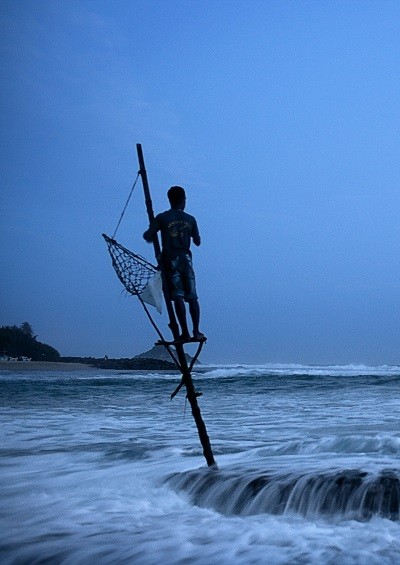Fishermen in Coastal Sri Lanka
Despite great hardship, the Nishanti family remain in their coastal home.

Credit: Florian Müller/The Other Hundred
“Following the tradition of humanistic photojournalism,” writes photographer Florian Müller, “I feel strongly committed to concerned photography and express my respect and empathy through this powerful medium.
As good images take time and understanding, I like to work intensively on deeper perspective projects to raise awareness and responsibility on social grievances.”
For 30 kilometers along Sri Lanka’s southern coast, between the towns of Unawatuna and Weilgama, fishermen such as Sunil Nishanti sit motionless on wooden stilts a few dozen meters from the shoreline.
The technique may be unique, but it is a fairly recent innovation, first adopted just after the Second World War when fishing spots on rocks and cliffs along the coast became too crowded.
Men started fishing from the wrecks of boats and aircraft left behind by the war, then some of them moved to stilts erected at fixed locations, which they then passed on to their sons.
The practice is unlikely to last much longer other than as a tourist attraction. Local fisheries are in decline, particularly following permanent alterations to the shoreline brought about by the Indian Ocean tsunami of 2004.
The returns from fishing, never good, are worsening, and few fisherman pass their stilts to their sons, instead renting them to other men who find it easier and more lucrative to pose for photographs.
For now, Sunil still earns his living from fishing. He and his family lost almost everything when the tsunami of 2004 flooded the bay where they lived. He declined a government offer to give him a new house on higher ground – the bus commute would have been too expensive, and anyway he wanted to live near the sea.
For most of the year, he sells what he catches from his stilt. During the monsoon season, when fish tend to avoid shallow waters, he buys fish caught by trawlers which he then resells in his village. Other fishermen spend the period working as fruit and vegetable vendors or as seasonal agricultural workers.
Text and photographs by Florian Müller
Before sunrise, Sunil walks across coral and rocks in the bay of Ahangama on the way to his stilt.
Shamila Nishanti, Sunil’s daughter, prepares fish caught by her father. His catch is often small – just a few fish, each just a few centimetres long, and not enough to feed his family.
 “Following the tradition of humanistic photojournalism, I feel strongly committed to concerned photography and express my respect and empathy through this powerful medium. As good images take time and understanding, I like to work intensively on deeper perspective projects to raise awareness and responsibility on social grievances.”
“Following the tradition of humanistic photojournalism, I feel strongly committed to concerned photography and express my respect and empathy through this powerful medium. As good images take time and understanding, I like to work intensively on deeper perspective projects to raise awareness and responsibility on social grievances.”The Other Hundred is a unique photo-book project (order here) aimed as a counterpoint to the Forbes 100 and other media rich lists by telling the stories of people around the world who are not rich but who deserve to be celebrated.
Its 100 photo-stories move beyond the stereotypes and cliches that fill so much of the world’s media to explore the lives of people whose aspirations and achievements are at least as noteworthy as any member of the world’s richest 1,000.
 Selected from 11,000 images shot in 158 countries and submitted by nearly 1,500 photographers, The Other Hundred celebrates those who will never find themselves on the world’s rich lists or celebrity websites.
Selected from 11,000 images shot in 158 countries and submitted by nearly 1,500 photographers, The Other Hundred celebrates those who will never find themselves on the world’s rich lists or celebrity websites.
































